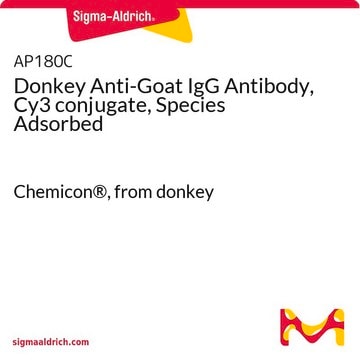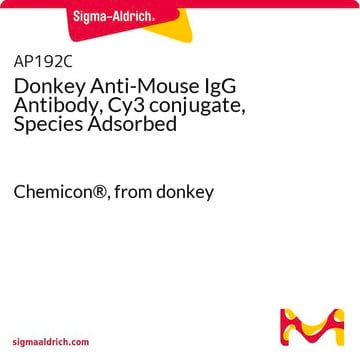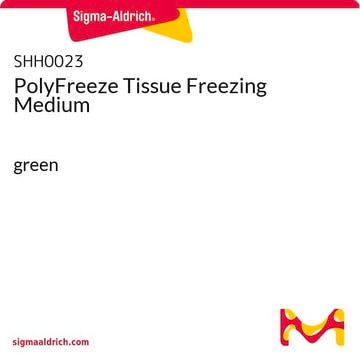AP182C
Donkey Anti-Rabbit IgG Antibody, Cy3 conjugate, Species Adsorbed
Chemicon®, from donkey
Synonym(s):
Donkey Anti-Rabbit Cy3
Sign Into View Organizational & Contract Pricing
All Photos(2)
About This Item
UNSPSC Code:
12352203
eCl@ss:
32160702
NACRES:
NA.46
Recommended Products
biological source
donkey
Quality Level
conjugate
CY3 conjugate
antibody form
F(ab′)2 fragment of affinity isolated antibody
antibody product type
secondary antibodies
clone
polyclonal
species reactivity
rabbit
manufacturer/tradename
Chemicon®
technique(s)
immunofluorescence: suitable
shipped in
wet ice
target post-translational modification
unmodified
General description
Immunoglobulin G (IgG), is one of the most abundant proteins in human serum with normal levels between 8-17 mg/mL in adult blood. IgG is important for our defence against microorganisms and the molecules are produced by B lymphocytes as a part of our adaptive immune response. The IgG molecule has two separate functions; to bind to the pathogen that elicited the response and to recruit other cells and molecules to destroy the antigen. The variability of the IgG pool is generated by somatic recombination and the number of specificities in an individual at a given time point is estimated to be 1011 variants.
Application
This Donkey anti-Rabbit IgG Antibody, Cy3 conjugate, Species Adsorbed is validated for use in IF for the detection of Donkey Rabbit IgG.
Physical form
Lyophilized. Buffer = 0.01M Sodium Phosphate, 0.25M NaCl, pH 7.6 with 15 mg/mL BSA, and 0.05% sodium azide.
Other Notes
Concentration: variable
Legal Information
CHEMICON is a registered trademark of Merck KGaA, Darmstadt, Germany
Not finding the right product?
Try our Product Selector Tool.
Hazard Statements
Precautionary Statements
Hazard Classifications
Aquatic Chronic 3
Storage Class Code
11 - Combustible Solids
WGK
WGK 3
Certificates of Analysis (COA)
Search for Certificates of Analysis (COA) by entering the products Lot/Batch Number. Lot and Batch Numbers can be found on a product’s label following the words ‘Lot’ or ‘Batch’.
Already Own This Product?
Find documentation for the products that you have recently purchased in the Document Library.
A ROCK Inhibitor Blocks the Inhibitory Effect of Chondroitin Sulfate Proteoglycan on Morphological Changes of Mesenchymal Stromal/Stem Cells into Neuron-Like Cells.
Lim, HS; Joe, YA
Biomolecules & Therapeutics null
John Malysz et al.
American journal of physiology. Gastrointestinal and liver physiology, 312(3), G228-G245 (2016-12-17)
Myenteric plexus interstitial cells of Cajal (ICC-MY) in the small intestine are Kit+ electrical pacemakers that express the Ano1/TMEM16A Ca2+-activated Cl- channel, whose functions in the gastrointestinal tract remain incompletely understood. In this study, an inducible Cre-LoxP-based approach was used
Low Mr phosphotyrosine protein phosphatase associates and dephosphorylates p125 focal adhesion kinase, interfering with cell motility and spreading.
Rigacci, S; Rovida, E; Dello Sbarba, P; Berti, A
The Journal of Biological Chemistry null
Kon Chu et al.
Epilepsia, 49(10), 1723-1732 (2008-05-16)
Erythropoietin (EPO) has neuron and astroglial protective effects via reduction of tissue-injuring molecules such as reactive oxygen species, glutamate, inflammatory cytokines, and other damaging molecules. Although EPO may constitute an effective therapeutic modality in cases of epileptic insult, no study
Jia Wang et al.
BMC nephrology, 18(1), 227-227 (2017-07-12)
According to renal M type phospholipase A2 receptor (PLA2R) immunohistochemistry, idiopathic membranous nephropathy (IMN) could be categorized into PLA2R-associated and non-PLA2R-associated IMN. We conducted a retrospective, multicenter cohort study with 91 patients to compare the effect of immunosuppressive therapy between
Our team of scientists has experience in all areas of research including Life Science, Material Science, Chemical Synthesis, Chromatography, Analytical and many others.
Contact Technical Service








